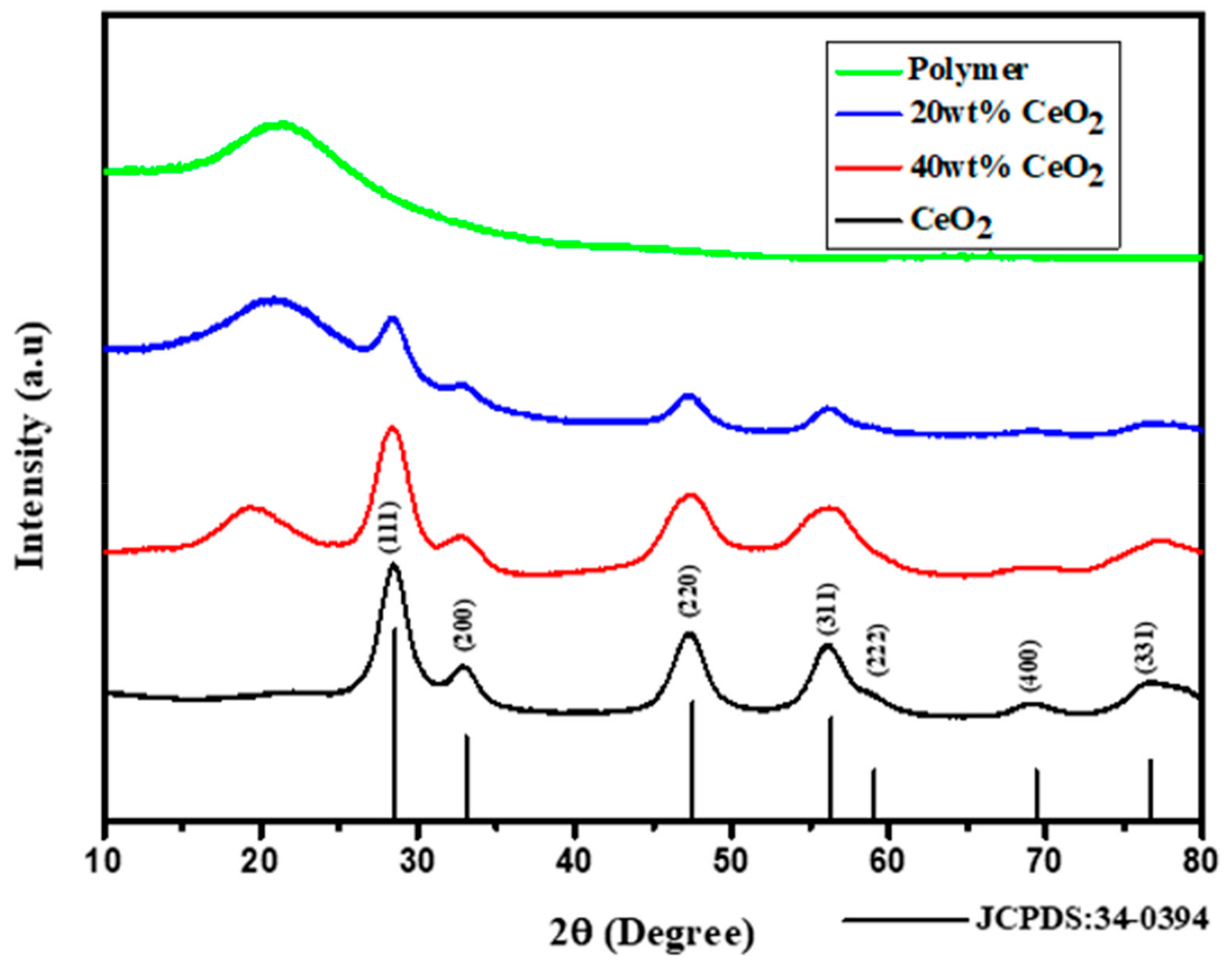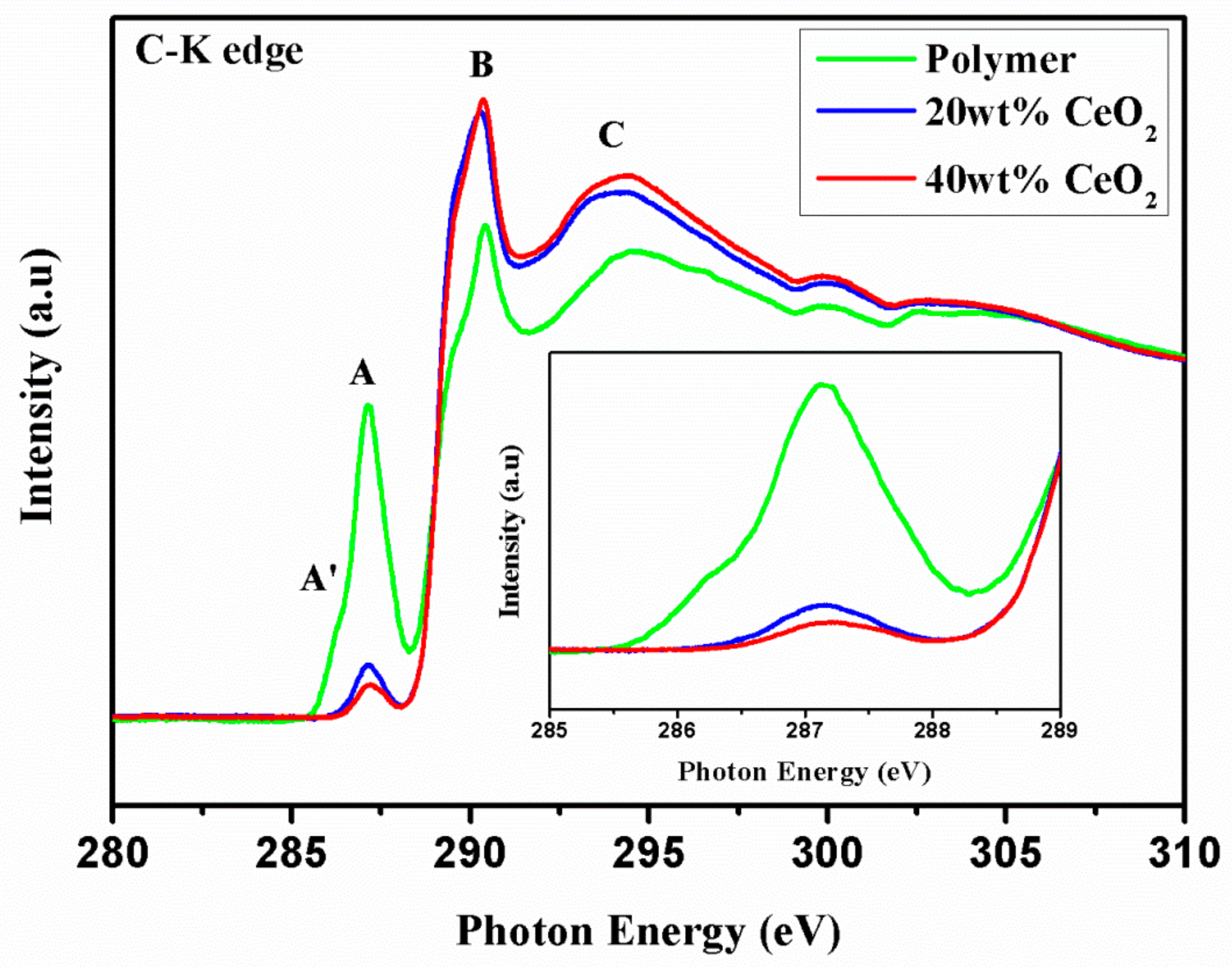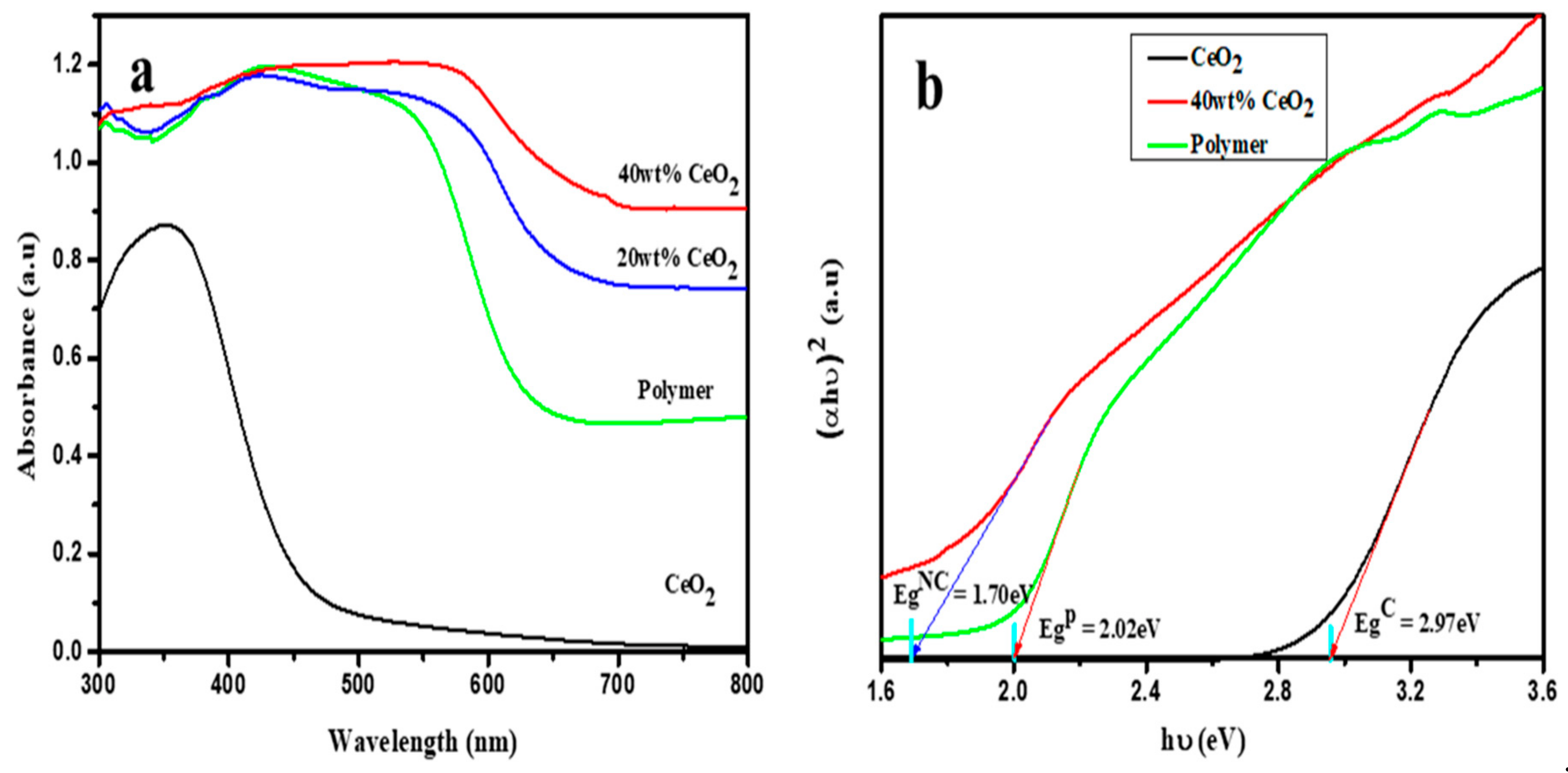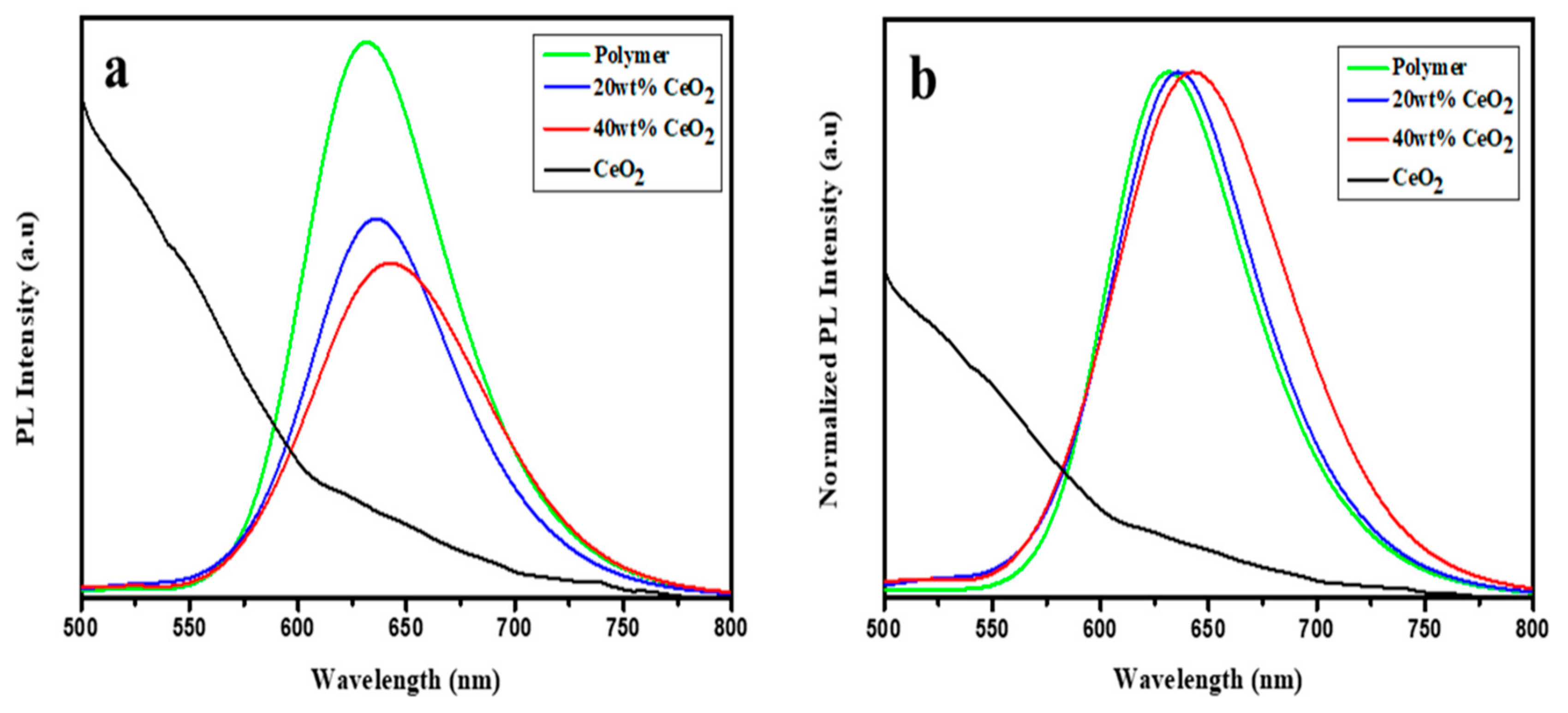Interface Interactions in Conjugated Polymer Composite with Metal Oxide Nanoparticles
Abstract
1. Introduction
2. Experimental Procedure
2.1. Synthesis of Polymer
2.2. Synthesis of Ceria Nanoparticles
2.3. Synthesis of CeO2/Polymer Nanoparticle (NP) Composites
2.4. Characterization
3. Results and Discussion
3.1. Microstructure of the Composites
3.2. Optical Properties of the Composites
3.3. Magnetic Property of the Composites
4. Conclusions
Supplementary Materials
Author Contributions
Funding
Acknowledgments
Conflicts of Interest
Abbreviations
References
- Bellucci, S.; Bolesta, I.; Guidi, M.C.; Karbovnyk, I.; Lesivciv, V.; Micciulla, F.; Pastore, R.; Popov, A.I.; Velgosh, S. Cadmium clusters in CdI2 layered crystals: The influence on the optical properties. J. Phys. Condens. Matter 2007, 19, 395015. [Google Scholar] [CrossRef]
- Song, S.; Kotobuki, M.; Zheng, F.; Xu, C.; Savilov, S.V.; Hu, N.; Lu, L.; Wang, Y.; Li, W.D.Z. A hybrid polymer/oxide/ionic-liquid solid electrolyte for Na-metal batteries. J. Mater. Chem. A 2017, 5, 6424–6431. [Google Scholar] [CrossRef]
- Velayutham, P.; Sahu, A.; Parthasarathy, S. A Nafion-Ceria Composite Membrane Electrolyte for Reduced Methanol Crossover in Direct Methanol Fuel Cells. Energies 2017, 10, 259. [Google Scholar] [CrossRef]
- Mohanapriya, M.K.; Deshmukh, K.; Ahamed, M.B.; Chidambaram, K.; Khadheer Pasha, S.K. Influence of Cerium Oxide (CeO2) Nanoparticles on the Structural, Morphological, Mechanical and Dielectric Properties of PVA/PPy Blend Nanocomposites. Mater. Today Proc. 2016, 3, 1864–1873. [Google Scholar] [CrossRef]
- Zhang, L.; Chen, S.; Yuan, S.; Wang, D.; Hu, P.-H.; Dang, Z.-M. Low dielectric loss and weak frequency dependence of dielectric permittivity of the CeO2/polystyrene nanocomposite films. Appl. Phys. Lett. 2014, 105, 052905. [Google Scholar] [CrossRef]
- Li, Y.; Zhang, J.; Ni, X.; Wang, L.; Yang, C. Facile fabrication of raspberry-like polystyrene/ceria composite particles and their catalytic application. Colloids Surfaces A 2018, 538, 818–824. [Google Scholar] [CrossRef]
- Sabitha, G.; Reddy, K.B.; Yadav, J.S.; Shailaja, D.; Sivudu, K.S. Ceria/vinylpyridine polymer nanocomposite: An ecofriendly catalyst for the synthesis of 3,4-dihydropyrimidin-2(1H)-ones. Tetrahedron Lett. 2005, 46, 8221–8224. [Google Scholar] [CrossRef]
- Ecco, L.G.; Fedel, M.; Ahniyaz, A.; Deflorian, F. Influence of polyaniline and cerium oxide nanoparticles on the corrosion protection properties of alkyd coating. Prog. Org. Coat. 2014, 77, 2031–2038. [Google Scholar] [CrossRef]
- Eduok, U.; Jossou, E.; Tiamiyu, A.; Omale, J.; Szpunar, J. Ceria/Acrylic Polymer Microgel Composite: Synthesis, Characterization, and Anticorrosion Application for API 5L X70 Substrate in Chloride-Enriched Medium. Ind. Eng. Chem. Res. 2017, 56, 5586–5597. [Google Scholar] [CrossRef]
- Park, S.; Park, C.; Yoon, H. Chemo-Electrical Gas Sensors Based on Conducting Polymer Hybrids. Polymers 2017, 9, 155. [Google Scholar] [CrossRef]
- Ansari, A.A.; Khan, M.A.M.; Khan, M.N.; Alrokayan, S.A.; Alhoshan, M.; Alsalhi, M.S. Optical and electrical properties of electrochemically deposited polyaniline/CeO2hybrid nanocomposite film. J. Semicond. 2011, 32, 043001. [Google Scholar] [CrossRef]
- Itoh, T.; Uchida, T.; Izu, N.; Matsubara, I.; Shin, W. Effect of Core-Shell Ceria/Poly(vinylpyrrolidone) (PVP) Nanoparticles Incorporated in Polymer Films and Their Optical Properties. Materials 2013, 6, 2119–2129. [Google Scholar] [CrossRef] [PubMed]
- Aguirre, M.; Paulis, M.; Leiza, J.R. UV screening clear coats based on encapsulated CeO2 hybrid latexes. J. Mater. Chem. A 2013, 1, 3155. [Google Scholar] [CrossRef]
- Aklalouch, M.; Calleja, A.; Granados, X.; Ricart, S.; Boffa, V.; Ricci, F.; Puig, T.; Obradors, X. Hybrid sol–gel layers containing CeO2 nanoparticles as UV-protection of plastic lenses for concentrated photovoltaics. Sol. Energy Mater. Sol. Cells 2014, 120, 175–182. [Google Scholar] [CrossRef]
- Liu, K.-Q.; Kuang, C.-X.; Zhong, M.-Q.; Shi, Y.-Q.; Chen, F. Synthesis, characterization and UV-shielding property of polystyrene-embedded CeO2 nanoparticles. Opt. Mater. 2013, 35, 2710–2715. [Google Scholar] [CrossRef]
- Guo, Q.; Ghadiri, R.; Weigel, T.; Aumann, A.; Gurevich, E.L.; Esen, C.; Medenbach, O.; Cheng, W.; Chichkov, B.; Ostendorf, A. Comparison of in Situ and ex Situ Methods for Synthesis of Two-Photon Polymerization Polymer Nanocomposites. Polymers 2014, 6, 2037–2050. [Google Scholar] [CrossRef]
- Da Silva, F.C.; Pinheiro da Silva, M.F.; Briotto Filho, D.; José Politi, M.; Bacani, R.; Rezende Triboni, E. Tuned charge-transfer between ceria and 1,4,5,8-naphthaldiimide as a function of pH. J. Lumin. 2018, 194, 240–247. [Google Scholar] [CrossRef]
- Dahle, J.T.; Arai, Y. Environmental geochemistry of cerium: Applications and toxicology of cerium oxide nanoparticles. Int. J. Environ. Res. Public Health 2015, 12, 1253–1278. [Google Scholar] [CrossRef]
- Masui, T.; Machida, K.; Sakata, T.; Mori, H.; Adachi, G. Preparation and characterization of cerium oxide ultrafine particles dispersed in polymer thin films. J. Alloys Compd. 1997, 256, 97–101. [Google Scholar] [CrossRef]
- Wang, W.; Zhang, B.; Jiang, S.; Bai, H.; Zhang, S. Use of CeO(2) Nanoparticles to Enhance UV-Shielding of Transparent Regenerated Cellulose Films. Polymers 2019, 11, 458. [Google Scholar] [CrossRef]
- Yu, C.Y.; Hsu, Y.-J. Synthesis, characterization, optical and electrochemical properties of spirobifluorene based polymers containing electron deficient moieties. Polymer 2016, 84, 65–71. [Google Scholar] [CrossRef]
- Nachimuthu, P.; Shih, W.-C.; Liu, R.-S.; Jang, L.-Y.; Chen, J.-M. The Study of Nanocrystalline Cerium Oxide by X-Ray Absorption Spectroscopy. J. Solid State Chem. 2000, 149, 408–413. [Google Scholar] [CrossRef]
- Lee, W.; Chen, S.-Y.; Chen, Y.-S.; Dong, C.-L.; Lin, H.-J.; Chen, C.-T.; Gloter, A. Defect Structure Guided Room Temperature Ferromagnetism of Y-Doped CeO2 Nanoparticles. J. Phys. Chem. C 2014, 118, 26359–26367. [Google Scholar] [CrossRef]
- Liu, Y.; Lockman, Z.; Aziz, A.; MacManus-Driscoll, J. Size dependent ferromagnetism in cerium oxide (CeO2) nanostructures independent of oxygen vacancies. J. Phys. Condens Matter 2008, 20, 165201. [Google Scholar] [CrossRef]
- Li, M.; Ge, S.; Qiao, W.; Zhang, L.; Zuo, Y.; Yan, S. Relationship between the surface chemical states and magnetic properties of CeO2 nanoparticles. Appl. Phys. Lett. 2009, 94, 152511. [Google Scholar] [CrossRef]
- Coey, J.M.D.; Venkatesan, M.; Fitzgerald, C.B. Donor impurity band exchange in dilute ferromagnetic oxides. Nat. Mater. 2005, 4, 173–179. [Google Scholar] [CrossRef]
- Coey, J.M.D.; Stamenov, P.; Gunning, R.; Venkatesan, M.; Paul, K. Ferromagnetism in defect-ridden oxides and related materials. N. J. Phys. 2010, 12, 053025. [Google Scholar] [CrossRef]
- Coey, M.; Ackland, K.; Venkatesan, M.; Sen, S. Collective magnetic response of CeO2 nanoparticles. Nat. Phys. 2016, 12, 694. [Google Scholar] [CrossRef]
- Yang, B.; Xiao, Z.; Yuan, Y.; Jayaraman, T.V.; Shield, J.E.; Skomski, R.; Huang, J. Room-temperature organic ferromagnetism in the crystalline poly(3-hexylthiophene): Phenyl-C61-butyric acid methyl ester blend film. Polymer 2013, 54, 490–494. [Google Scholar] [CrossRef]







© 2019 by the authors. Licensee MDPI, Basel, Switzerland. This article is an open access article distributed under the terms and conditions of the Creative Commons Attribution (CC BY) license (http://creativecommons.org/licenses/by/4.0/).
Share and Cite
Atisme, T.B.; Yu, C.-Y.; Tseng, E.N.; Chen, Y.-C.; Shu, P.-K.; Chen, S.-Y. Interface Interactions in Conjugated Polymer Composite with Metal Oxide Nanoparticles. Nanomaterials 2019, 9, 1534. https://doi.org/10.3390/nano9111534
Atisme TB, Yu C-Y, Tseng EN, Chen Y-C, Shu P-K, Chen S-Y. Interface Interactions in Conjugated Polymer Composite with Metal Oxide Nanoparticles. Nanomaterials. 2019; 9(11):1534. https://doi.org/10.3390/nano9111534
Chicago/Turabian StyleAtisme, Tsegaye Belege, Chin-Yang Yu, Eric Nestor Tseng, Yi-Che Chen, Pei-Kai Shu, and Shih-Yun Chen. 2019. "Interface Interactions in Conjugated Polymer Composite with Metal Oxide Nanoparticles" Nanomaterials 9, no. 11: 1534. https://doi.org/10.3390/nano9111534
APA StyleAtisme, T. B., Yu, C.-Y., Tseng, E. N., Chen, Y.-C., Shu, P.-K., & Chen, S.-Y. (2019). Interface Interactions in Conjugated Polymer Composite with Metal Oxide Nanoparticles. Nanomaterials, 9(11), 1534. https://doi.org/10.3390/nano9111534




